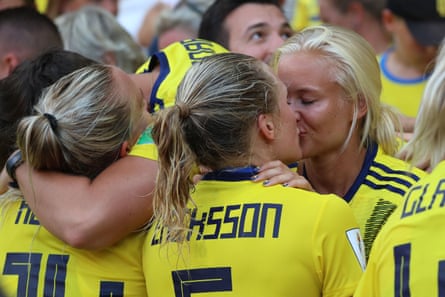[ad_1]
It is a picture of a kiss – an everyday human interaction between partners after 90 minutes on opposing sides. Posted by Football Is Everywhere along with the caption “Football is Love, everywhere”, the photo of the Swedish top-flight players Anna Tamminen and Rosa Herreros is a perfect example of a sport renowned for its inclusiveness.
On 15 April, top of the table Hammarby hosted Växjö in the third game of the Swedish domestic top-flight season. It was the first time that Tamminen and Herreros had faced each other on the field, a unique situation for the couple but far from uncommon in the women’s game. The 28-year-old Tamminen started in goal for Hammarby, helping her team to a 6-1 victory, while Herreros was named on the visitors’ bench and did not make an appearance. After the final whistle and the work on the pitch was done, the couple greeted each other with this simple moment of affection caught by a waiting photographer.
Reaction, overall, has been largely positive reflecting the accepting nature of the game. The series of rainbow emojis and “love is love” replies below the post demonstrate the positive impact visibility can have. However, as is the nature with social media, it has unfortunately also garnered a few negative responses. Questions have been raised about professionalism and whether the pitch is the right place for these interactions, especially with players on opposing sides.
What these posters fail to understand is the unique position women’s football holds within sport and society as a whole. In stark contrast to their male counterparts, many players feel comfortable and supported enough to be open about their sexuality. Couples are common and well-known across the sport, and while more often than not they play for the same side, they are not restricted by the harmful and antiquated norms held by some fans in the men’s game. In addition, many of these same couples understand the power of their platforms to try to tackle the considerable inequality LGBTQIA+ people still face in speaking openly about their relationships.
There have been many occasions where photographers have captured such interactions between players. One went viral when the Australia captain, Sam Kerr, and the American Kristie Mewis were pictured in a touching embrace on the pitch at the Tokyo Olympics. The USA had just beaten Kerr’s side in a seven-goal thriller to secure bronze and Mewis was comforting her girlfriend, a private exchange juxtaposed with its public setting.
Another image that took the internet by storm was the kiss between Pernille Harder and Magdalena Eriksson after Sweden had knocked Canada out of the 2019 World Cup. With Denmark absent from the tournament, Harder attended, wearing a Sweden shirt, to support her long-time partner through her journey to a bronze medal. It has become an iconic moment in the sport and the two Chelsea players now consciously speak up and advocate for equality and their community.

Most importantly, however, is the fact that none of these should be seen as anything more than the inherently human reactions they are. Across sport, the emotions and interactions of athletes are photographed, in both victory and defeat and regardless of sexuality. Whether it’s the brothers Jason and Travis Kelce embracing after facing off against each other in this year’s Super Bowl, Alex Morgan’s daughter playing on the pitch after an international or Julie Ertz kissing her husband, Zach, pitchside after winning the 2019 World Cup, these are all moments caught on camera that bring the joy of sport to life. A celebration of the athlete and everyone around them that has helped them arrive at that point.
The photo of Tamminen and Herreros was not on this scale of celebration. In contrast, it was an intrinsically ordinary situation, a couple returning to each other after a day at work. But the power of a photograph is significant, and in bringing it to life, it has perfectly encapsulated a sport that has built its foundations and values on acceptance. A game that has found its own identity and space despite the constant attempts to police it from those on the outside. Comparisons with the men are constant and frustrating, with that side often viewed as the pinnacle of how things should be despite its evident frailties. Women’s football, however, despite being in its relative infancy, has the power to shape a new vision. It is a prism through which you can see a safer, more inclusive sport that can combine competitiveness and professionalism with inclusivity, empathy and a feeling that football really can be a place for all. Where for 90 minutes on the pitch, you are rivals; but once the final whistle goes, love, respect and relationships can exist.
after newsletter promotion
Recommended viewing
Caroline Graham Hansen’s fourth-minute strike against Chelsea was a stand-out from the weekend. The Barcelona player glided across the pitch before unleashing an unstoppable finish past Ann-Katrin Berger. This goal from Wave’s Sofia Jakobsson against Angel City is also worthy of a watch.
Have a question for our writers – or want to suggest a topic to cover? Get in touch by emailing moving.goalposts@theguardian.com or post BTL.
[ad_2]
#shouldnt #opponents #kiss #game
( With inputs from : www.theguardian.com )

Leave a Reply